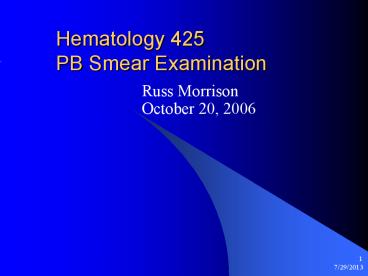Hematology 425 PB Smear Examination - PowerPoint PPT Presentation
1 / 15
Title:
Hematology 425 PB Smear Examination
Description:
Hematology 425 PB Smear Examination Russ Morrison October 20, 2006 PB Smear The well-made, well-stained blood smear can provide valuable information More can be ... – PowerPoint PPT presentation
Number of Views:107
Avg rating:3.0/5.0
Title: Hematology 425 PB Smear Examination
1
Hematology 425 PB Smear Examination
- Russ Morrison
- October 20, 2006
2
PB Smear
- The well-made, well-stained blood smear can
provide valuable information - More can be learned from this procedure than any
other single hematologic test - WBC and platelet counts can be estimated
- Proportions of different types of WBCs can be
observed - Morphology of the three circulating cell lines
(RBC, WBC, platelet) can be evaluated for
abnormalities
3
PB Smear Preparation
- EDTA-anticoagulated blood is collected in a
purple top tube - EDTA anticoagulates the blood by chelating
calcium required for coagulation - Smears should be prepared within 2 to 3 hours of
collection the EDTA anticoagulated sample - Blood more than 5 hours old shows RBC artifact
(echinocyte, spherocyte, necrobiotic leukocytes,
vacuolated neutrophils and monocytes)
4
PB Smear Preparation
- Advantage of making smears from a tube of blood
is that multiple slides can be made and the
timing of slide making can be postponed - Platelet estimates are more accurated when
anticoagulated blood is used to prepare the smear - Some still believe that direct preparation of
smears is best to evaluate blood cells and their
morphology
5
PB Smear Preparation
- EDTA can be a source of error
- Platelet satellitosis can cause a
pseudothrombocytopenia - Platelet clumping can cause low platelet and
increased WBC dounts - These problems may be eliminated using sodium
citrate as an anticoagulant
6
- Platelet satellitosis, (platelets encircling a
neutrophil) occurs when a patient has a serum
factor that reacts to the anticoagulant EDTA
7
PB Smear Preparation
- PB smears may also be made directly from finger
or heel punctures at the patients side. - Limitations of direct prep
- Platelet clumping can be expected
- Limited number of smears can be made
8
PB Smear Preparation
- Techniques for making PB Smears
- Manual wedge technique
- Coverslip technique
- Automated slide maker
- Regardless of method, smears should be dired
quickly to avoid drying artifact (moth-eaten
looking red cells)
9
Staining of PB Smears
- Ronamowsky Stains such as Wrights or
Wright-Giemsa stain are most often used - They are polychrome stains because both eosin and
methylene blue are used - Methanol in the slide fixes the cells to the
slide - A buffer facilitates the staining action
- Staining reactions are pH-dependent
10
Staining of PB Smears
- Methylene blue is basic and stains acidic
cellular components such as RNA - Eosin is acidic and stains basic components such
as Hgb or eosiniphilic granules - Slides may be stained manually or with automated
stainers
11
PB Smear Examination
- 10X or Low Power
- Assess the overall quality of the smear,
including abnormal distribution of RBCs,
agglutination or a disproportionate number of
large nucleated cells at the edge of the smear.
If any of the above conditions exist, a new smear
should be prepared. While scanning with this
lens, check to see if abnormal cells such as
blasts, reactive lymphs or parasites are present.
Also check for clumps of platelets which may
indicate inadequate anticoagulation of the sample
(partial clotting).
12
PB Smear Examination
- 40X or High Dry
- Using the 40X (high dry) objective, find an area
of the smear in which the RBCs are evenly
distributed and barely touch one another. Scan 8
to 10 fields in this area of the smear and
determine the average number of white blood cells
(WBCs) per field. The average number of WBCs per
high power field multiplied by 2000 gives an
approximation of the total WBC count/mm3.
Discrepancies between the WBC estimate and the
machine count should be resolved.
13
PB Smear Examination
- 100X or Oil Immersion
- In the same area of the smear as used for 40X
review, perform the WBC differential. Count 100
consecutive WBCs in a systematic manner using the
battlement track (Figure 1-6) of the Hematology
atlas. Results are reported as a for each type
of cell seen during the differential. NRBCs are
also counted during the differential, if seen,
and reported as NRBCs/100 WBCs. Evaluate the
RBC morphology in relation to size, shape and
color of the RBCs on the smear. Results of the
RBC evaluation should be consistent with the
indices reported by the hematology
instrumentation.
14
PB Smear Examination
- 100X or Oil Immersion
- The final step with the 100x objective is to
estimate the platelet count. In the same area
where the differential was performed, count the
number of platelets in 10 oil immersion fields.
The average number of platelets in those 10
fields multiplied by 20,000 will provide an
estimate of the platelet count which should match
the automated count within reason. The platelet
estimate is reported as decreased, adequate or
increased (using 150 to 450 x 103/ul as the
reference range).
15
PB Smear Examination
- Platelet number is reported as adequate,
increased or decreased - RBC morphology is evaluated in regard to presence
of anisocytosis and poikilocytosis - Anisocytosis is quantitated when greater than
normal, poikilocytosis is quantitated and the
poikilocytes present are identified































